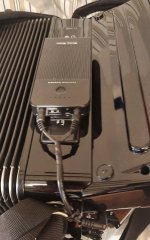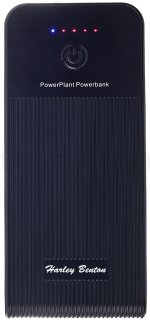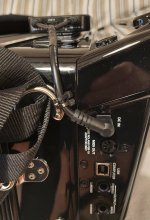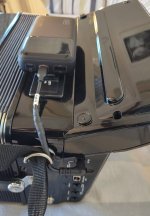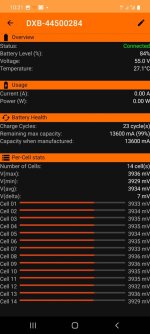I'm new here, so sorry if this has been well covered (I did search, but found nothing...)
I'm a jazz/latin player of many years (flute, 7-string nylon guitar mostly) but am just starting out on a CBA adventure - as a complete beginner! And since I haven't grown up with the sounds of acoustic accordions, it's quite natural for me to start with a ROLAND FR1XB for all its documented advantages. I have a lot of stage/audio kit already, so the ability to just "plug in" is a huge advantage for me. And if I ever get good enough to play on stage, I can use my existing wireless rig to move around freely on stage without tripping over wires.
But I have to say that the BATTERY arrangement on these accordions is very poor! Removing a stack of AA cells and recharging every ~5 hours is a step too far for me. So I've instead adopted a POWERBANK of the kind used for powering guitar pedals - basically a Lithium pack with controlling electronics in a small case that can be recharged in situ. My blurry photo shows this attached to the instrument - basically fastened to the outside of the battery door using 3M Dual Lock (a kind of industrial super-velcro). Note that is glued only to the battery door, which is a cheap plastic replaceable part. The instrument is unchanged.
The powerbank I used is a Harley Benton from Thomann, which I already had. It actually produces 2 x 9v which I had to join together (hence the 2 wires). In theory, the max output is only 1.2 amps, while the Roland power adaptor is rated for 2 amps - but my tests show that the instrument never draws more than 1 amp even at full volume with loads of notes pressed. Lithium powerbanks have a significantly higher capacity than AA cells of a given size/weight, and I calculate this should give me 8+ hours with speakers on, or 14 hours on headphones - for a weight of 220g.
Note there are other power banks, designed for driving phones and laptops, that look even better than the one I chose - in particular those that support the PD 3.0 (Power delivery) protocol. The way PD works is that you buy a special cable that contains a chip in the USB-C connector that "negotiates" the voltage required - 9v in this case. This looks like a brilliant solution BUT two of these that I tried had the same problem, namely that the 9 volts would not re-establish on power on! You had to physically unplug and reconnect the 9v cable to trigger the negotiation (the "plug and play" idea). So I used my Harley Benton one which produces an old-fashioned "fixed" 9 volts.
Now I just have to learn the bloody instrument!
I'm a jazz/latin player of many years (flute, 7-string nylon guitar mostly) but am just starting out on a CBA adventure - as a complete beginner! And since I haven't grown up with the sounds of acoustic accordions, it's quite natural for me to start with a ROLAND FR1XB for all its documented advantages. I have a lot of stage/audio kit already, so the ability to just "plug in" is a huge advantage for me. And if I ever get good enough to play on stage, I can use my existing wireless rig to move around freely on stage without tripping over wires.
But I have to say that the BATTERY arrangement on these accordions is very poor! Removing a stack of AA cells and recharging every ~5 hours is a step too far for me. So I've instead adopted a POWERBANK of the kind used for powering guitar pedals - basically a Lithium pack with controlling electronics in a small case that can be recharged in situ. My blurry photo shows this attached to the instrument - basically fastened to the outside of the battery door using 3M Dual Lock (a kind of industrial super-velcro). Note that is glued only to the battery door, which is a cheap plastic replaceable part. The instrument is unchanged.
The powerbank I used is a Harley Benton from Thomann, which I already had. It actually produces 2 x 9v which I had to join together (hence the 2 wires). In theory, the max output is only 1.2 amps, while the Roland power adaptor is rated for 2 amps - but my tests show that the instrument never draws more than 1 amp even at full volume with loads of notes pressed. Lithium powerbanks have a significantly higher capacity than AA cells of a given size/weight, and I calculate this should give me 8+ hours with speakers on, or 14 hours on headphones - for a weight of 220g.
Note there are other power banks, designed for driving phones and laptops, that look even better than the one I chose - in particular those that support the PD 3.0 (Power delivery) protocol. The way PD works is that you buy a special cable that contains a chip in the USB-C connector that "negotiates" the voltage required - 9v in this case. This looks like a brilliant solution BUT two of these that I tried had the same problem, namely that the 9 volts would not re-establish on power on! You had to physically unplug and reconnect the 9v cable to trigger the negotiation (the "plug and play" idea). So I used my Harley Benton one which produces an old-fashioned "fixed" 9 volts.
Now I just have to learn the bloody instrument!

